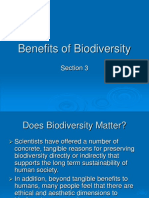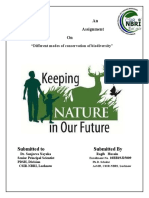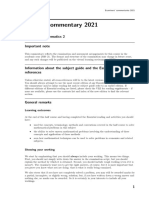Document (4) 3 Env
Document (4) 3 Env
Uploaded by
Adyasha RoutCopyright:
Available Formats
Document (4) 3 Env
Document (4) 3 Env
Uploaded by
Adyasha RoutOriginal Title
Copyright
Available Formats
Share this document
Did you find this document useful?
Is this content inappropriate?
Copyright:
Available Formats
Document (4) 3 Env
Document (4) 3 Env
Uploaded by
Adyasha RoutCopyright:
Available Formats
The variability of life on Earth is called Biodiversity.
Biodiversity takes
into account all the living organisms present on Earth.
A number of factors like pollution, erosion, evolution, urbanization,
industrialization, population, and depletion lead to the loss of
biodiversity.
Loss of biodiversity is very harmful to the ecosystem as it indicates
either loss of species, or reduction of species in a natural habitat, or
both of them on a global level.
It affects the ecosystem having impacts on the food chain. It affects
agriculture and weakens the resistance to natural disasters like floods,
drought, etc.
As the mankind is totally dependent on the nature, a threat to
biodiversity poses a threat to humankind.
For economic and various life support reasons, it is very important to
protect and preserve biodiversity.
Biodiversity conservation plays an important role in the quality of life of
all living organisms.
The protection and management of biodiversity in obtaining
sustainable development of resources are called Biodiversity
conservation.
Protection, restoration, and management of biodiversity in order to
derive sustainable benefits for present and future generations, Or, it
can also be defined as, the totality of genes, species, and ecosystems
in a defined area.
There are three major objectives of Biodiversity conservation:
a) Preservation of the diversity of species.
b) Sustainability of species and ecosystem.
c) Maintaining life-supporting and essential ecological processes
Biodiversity Conservation Methods
a) In-situ Conservation
In Situ Conservation refers to the preservation and protection of
the species in their natural habitat. (Conservation of genetic
resources in natural populations of plant or animal species)
In situ conservation involves the management of biodiversity in
the same area where it is found.
Advantages
It preserves species as well as their natural habitat.
It ensures protection to a large number of populations.
It is economic and a convenient method of conservation
It doesn’t require species to adjust to a new habitat.
Natural ecosystem is protected and maintained.
Exp-Biosphere reserves, national parks, wildlife sanctuaries, biodiversity
hotspots, gene sanctuary, and sacred groves.
b) Ex-situ Conservation
Ex Situ Conservation means conservation of life outside their
natural habitat or place of occurrence.
It is the method in which part of the population or the entire
endangered species is taken from its natural habitat which is
threatened and breeding and maintaining of these species take
place in artificial ecosystems(zoos, nurseries, botanical gardens).
The living environments are altered in these conservation sites,
so there are fewer survival struggles like scarcity of food, water,
or space.( competition among species for food or survival is low)
Advantages
Essential life-sustaining conditions like climate, food availability,
veterinary care can be altered and are under human control.
Artificial breeding methods can be introduced leading to successful
breeding and creating many more offspring of the species.
The species can be protected from poaching and population
management can be efficiently done.
Gene techniques can be applied to increase the population of the
species and they can again be reintroduced into the wild.
Strategies for Biodiversity Conservation
Conservation of all food varieties, timber plants, livestock, microbes,
and agricultural animals
Identification and conservation of all the economically important
organisms
Preservation of unique ecosystems should be done.
Efficient utilization of resources should be done.
Prevention of poaching and hunting of wild animals
Development of the reserves and protected areas
Reduction in the levels of pollutants in environment
Prohibition of deforestation
Strict environmental laws
Conservation of useful and endangered species of plants and
animals.
Convention on Biological Diversity
The Convention on Biological Diversity (CBD) is an international treaty aimed
at promoting sustainable development by
Conservation of Biological Diversity: This objective focuses on
preserving the variety of life on Earth, which includes the diversity of
ecosystems, species, and genetic resources. The goal is to maintain
and enhance biological diversity for the benefit of current and future
generations.
Sustainable Use of Its Components: This objective aims to ensure
that the use of biological resources (such as plants, animals, and
microorganisms) is done in a way that does not lead to their long-term
decline. It promotes practices that allow for the sustainable harvest
and management of these resources, ensuring they remain available
for future generations.
Fair and Equitable Sharing of the Benefits Arising from the
Utilization of Genetic Resources: This objective seeks to ensure
that the benefits derived from genetic resources (such as
pharmaceuticals, agricultural products, and biotechnological
innovations) are shared fairly and equitably with the countries and
communities that provide these resources. This includes benefits such
as financial profits, technology transfer, and capacity building.
The CBD was adopted at the Earth Summit in Rio de Janeiro in 1992 and
entered into force on December 29, 1993.
The Convention has two protocols, both of which take into account the needs
of, and commit to cooperating with, developing countries and “in particular”
those of LDCs and other groups of countries such as SIDS and Parties with
Economies in transition:
1. Nagoya Protocol on Access to Generic Resources and the Fair
and Equitable Sharing of Benefits Arising from their Utilization.
2. Cartagena Protocol on Biosafety to the Convention on
Biological Diversity (governs the movements of living modified
organisms – LMOs – resulting from modern biotechnology from one
country to another). Capacity-building, financial resources and access
to and transfer of technology and Parties commit to cooperating in the
development and/or strengthening of human resources and
institutional capacities in biosafety.
You might also like
- Quiz-Quiz Trade ReviewDocument59 pagesQuiz-Quiz Trade Reviewapi-299996815No ratings yet
- 4915536Document123 pages4915536josephvanbac89% (18)
- E Discovery OutlineDocument2 pagesE Discovery Outlinejackojidemasiado100% (1)
- Untitled DocumentDocument14 pagesUntitled DocumentGaurav GNo ratings yet
- Pathak 2014Document12 pagesPathak 2014rockfestNo ratings yet
- Biodiversity and ConservationDocument6 pagesBiodiversity and Conservationrakesh.lilasiNo ratings yet
- KavinDocument12 pagesKavinsharveshsampathNo ratings yet
- Types of BiodiversityDocument9 pagesTypes of BiodiversityFaiz Syed MohammedNo ratings yet
- Assignment No 3Document4 pagesAssignment No 3nabeel nadeemNo ratings yet
- BiodivesityDocument3 pagesBiodivesityanshul0714No ratings yet
- BIORESOURCE notesDocument25 pagesBIORESOURCE notesvaishnavi18162003No ratings yet
- 3cWfE - Research - Biodiversity ConservationDocument5 pages3cWfE - Research - Biodiversity ConservationErmiyas YeshitlaNo ratings yet
- Review Article Ex Situ Conservation of Biodiversity With ParticularDocument12 pagesReview Article Ex Situ Conservation of Biodiversity With ParticularRittik Ranjan Prasad XII BNo ratings yet
- Benefits of Biodiversity: Section 3Document8 pagesBenefits of Biodiversity: Section 3Usuizero TanNo ratings yet
- Biodiversity and conservation (1)Document6 pagesBiodiversity and conservation (1)4L Anisha SieudassNo ratings yet
- How To Preserve Flora and Fauna For Human Welfare Education Presentation in Green Pastel Nature StyleDocument15 pagesHow To Preserve Flora and Fauna For Human Welfare Education Presentation in Green Pastel Nature Stylenguyễn phạmNo ratings yet
- What Is Biodiversity ProjectDocument6 pagesWhat Is Biodiversity ProjectakhileshmoneyNo ratings yet
- Introduction To BiodiversityDocument10 pagesIntroduction To Biodiversitymundesandeep45No ratings yet
- Biodiversity: Life To Our Mother EarthDocument19 pagesBiodiversity: Life To Our Mother EarthAnil KumarNo ratings yet
- Biodiversity and Conversation (Done)Document3 pagesBiodiversity and Conversation (Done)MarieNo ratings yet
- Week 13Document28 pagesWeek 13blesstongga2002No ratings yet
- BIODIVERSITY AND ITS CONSERVATIONDocument23 pagesBIODIVERSITY AND ITS CONSERVATIONshinnosukenoharahNo ratings yet
- BiodiversityDocument23 pagesBiodiversityJoy CabansagNo ratings yet
- Biodiversity and Climate Change: OutlineDocument8 pagesBiodiversity and Climate Change: OutlinenilkanthretailenterpriseltdNo ratings yet
- Kavin PDFDocument11 pagesKavin PDFsharveshsampathNo ratings yet
- Biodiversity and Sustainable Development UPSCDocument10 pagesBiodiversity and Sustainable Development UPSCSOUTH HINDI DOUBBED NEW MOVIESNo ratings yet
- Introduction To BiodiversityDocument8 pagesIntroduction To BiodiversityAnnapoorneshwariNo ratings yet
- Levels of BiodiversityDocument4 pagesLevels of BiodiversityASWINI REEBA BENNYNo ratings yet
- Transpareny 3Document6 pagesTranspareny 3nitesh tirkeyNo ratings yet
- Are We Losing Our Indigenous VarietiesDocument13 pagesAre We Losing Our Indigenous VarietiesyesindiacanngoNo ratings yet
- Lesson 4 5Document8 pagesLesson 4 5jeffbacho889No ratings yet
- C. Biology PascoDocument10 pagesC. Biology PascodelalejusticeNo ratings yet
- Theme Biodiversity: Conservation and Agricultural SustenanceDocument2 pagesTheme Biodiversity: Conservation and Agricultural SustenancePaeng RafaelNo ratings yet
- Geo PPT (Shabd) - 1Document12 pagesGeo PPT (Shabd) - 1Tanya VermaNo ratings yet
- TanmayDocument11 pagesTanmayharshgaming9806No ratings yet
- Rida Genetics ArticleDocument8 pagesRida Genetics Articlenabeel nadeemNo ratings yet
- Project BioDocument17 pagesProject Biogovind717w76No ratings yet
- Sambhav Daksh Syed AbhimanyuDocument10 pagesSambhav Daksh Syed AbhimanyuDaksh ChauhanNo ratings yet
- In Situ and Ex Situ Conservation ComplemDocument12 pagesIn Situ and Ex Situ Conservation Complemrobertdebruce23No ratings yet
- Unit I Biodiversity Notes - 1Document23 pagesUnit I Biodiversity Notes - 1Durga DamleNo ratings yet
- Exploring BiodiversityDocument2 pagesExploring Biodiversityvoidmagic200No ratings yet
- Biodiversity and ConservationDocument2 pagesBiodiversity and Conservationakhsariaz786No ratings yet
- Biodiversity Conservation in IndiaDocument20 pagesBiodiversity Conservation in Indiaadeeba showkatNo ratings yet
- Evs Semester 3RD Notes in English MediumDocument55 pagesEvs Semester 3RD Notes in English MediumYes TheoryNo ratings yet
- Conservation of BiodiversityDocument16 pagesConservation of Biodiversitydayanidi.s.kNo ratings yet
- Biodiversity Loss DBITAMKB PDFDocument8 pagesBiodiversity Loss DBITAMKB PDFSnehal KoliNo ratings yet
- The Significance of Biodiversity ConservationDocument1 pageThe Significance of Biodiversity ConservationbarteksribdNo ratings yet
- Environmental Science AssignmentDocument8 pagesEnvironmental Science AssignmentsambitNo ratings yet
- 1 PBDocument10 pages1 PBRéka MolnárNo ratings yet
- Be A Part of The Plan KAVYA - EditedDocument3 pagesBe A Part of The Plan KAVYA - EditedPiyush GoyalNo ratings yet
- Unit - 3, EcosystemDocument42 pagesUnit - 3, Ecosystemambika KuityNo ratings yet
- Humans and Other Species: BiodiversityDocument3 pagesHumans and Other Species: BiodiversityZeesahnNo ratings yet
- Exam TopicsDocument7 pagesExam Topicsanith3042No ratings yet
- Biodiversity ConservationDocument19 pagesBiodiversity Conservation41-DanendraNo ratings yet
- Importance_of_Biodiversity_ConservationDocument4 pagesImportance_of_Biodiversity_Conservationanuragsenapati48No ratings yet
- The Importance of Biodiversity Conservation in Sustainable DevelopmentDocument1 pageThe Importance of Biodiversity Conservation in Sustainable Developmentfritzjhone8No ratings yet
- Introduction To Biological ConservationDocument34 pagesIntroduction To Biological Conservationlslamic StudioNo ratings yet
- Environment Programme, Biodiversity Typically Measures Variation at The Genetic, Species, and Ecosystem LevelDocument10 pagesEnvironment Programme, Biodiversity Typically Measures Variation at The Genetic, Species, and Ecosystem LevelCherry Ann JuitNo ratings yet
- Assignment: Sustainable SolutionsDocument4 pagesAssignment: Sustainable SolutionsSid sidNo ratings yet
- BiodverDocument12 pagesBiodverMUSEVENINo ratings yet
- Wildlife Preservation InitiativeDocument3 pagesWildlife Preservation Initiativey9pabloNo ratings yet
- Interrelationship Between Biotechnology and Biodiversity: Submitted byDocument15 pagesInterrelationship Between Biotechnology and Biodiversity: Submitted byprabhatNo ratings yet
- Biodiversity Finance: Innovative Tools for a Flourishing PlanetFrom EverandBiodiversity Finance: Innovative Tools for a Flourishing PlanetNo ratings yet
- ios mootDocument16 pagesios mootAdyasha RoutNo ratings yet
- Document Administrative Law 1Document6 pagesDocument Administrative Law 1Adyasha RoutNo ratings yet
- Administrative Law 2Document6 pagesAdministrative Law 2Adyasha RoutNo ratings yet
- Document EnvDocument2 pagesDocument EnvAdyasha RoutNo ratings yet
- 2 Tax MootDocument12 pages2 Tax MootAdyasha RoutNo ratings yet
- Postmodification by Infinitive and - Ing Non-Finite ClausesDocument3 pagesPostmodification by Infinitive and - Ing Non-Finite Clausesscribd3No ratings yet
- Technical Specifications For Bird Flight DiverterDocument19 pagesTechnical Specifications For Bird Flight DiverterVidyavathiDavuluriNo ratings yet
- Z200 Parts CatalogueDocument84 pagesZ200 Parts CatalogueJimmy AlemanNo ratings yet
- Lecture 11 Motion in A Plane Introduction To Polar CoordinatesDocument11 pagesLecture 11 Motion in A Plane Introduction To Polar CoordinatesAnonymous yorzHjDBdNo ratings yet
- Mexico TIN PDFDocument5 pagesMexico TIN PDFArtemioNo ratings yet
- GRADE 11 D AssignmentDocument4 pagesGRADE 11 D AssignmentPaul MunsakaNo ratings yet
- 177012-PDF-ENGDocument15 pages177012-PDF-ENGLizi SahiraNo ratings yet
- Maths Assignment 1 PDFDocument2 pagesMaths Assignment 1 PDFShubham GuptaNo ratings yet
- Brochure. 416 Series. Variable Axial Piston Pump. Options - FeaturesDocument4 pagesBrochure. 416 Series. Variable Axial Piston Pump. Options - FeaturesObaid Shaikh100% (1)
- MT105b Commentary 2021Document22 pagesMT105b Commentary 2021Tamara TopicNo ratings yet
- Smart Grid Pak PerspectiveDocument23 pagesSmart Grid Pak PerspectiveTaher QutubNo ratings yet
- Bioburden and PyronemaDocument10 pagesBioburden and PyronemaSaad Ali KhanNo ratings yet
- Aghorastra Mantra Sadhna Vidhi in Hindi & Sanskrit PDFDocument12 pagesAghorastra Mantra Sadhna Vidhi in Hindi & Sanskrit PDFsumit girdharwal80% (5)
- Combined Utility LayoutDocument1 pageCombined Utility LayoutShahul HameedNo ratings yet
- Effect of Grid-Form Deep Soil Mixing On The Liquefaction-Induced Foundation Settlement, Using Numerical ApproachDocument16 pagesEffect of Grid-Form Deep Soil Mixing On The Liquefaction-Induced Foundation Settlement, Using Numerical Approachm.hasanvandian75No ratings yet
- Tigini-2019-Wastewater-Agar As A Selection EnvDocument8 pagesTigini-2019-Wastewater-Agar As A Selection EnvEduard-Marius LungulescuNo ratings yet
- STG190C-8S (Weichai) 114115Document2 pagesSTG190C-8S (Weichai) 114115EduardoValdiviaNo ratings yet
- FBI Steel Targets Saftey PDFDocument2 pagesFBI Steel Targets Saftey PDFDanNo ratings yet
- Lesson 6: Dynamic Host Configuration Protocol DHCP (Part1)Document51 pagesLesson 6: Dynamic Host Configuration Protocol DHCP (Part1)Mahmmoud MahdiNo ratings yet
- 412FM04S02Document28 pages412FM04S02ppgl26febNo ratings yet
- Rasika DietitianDocument3 pagesRasika DietitianChrill DsilvaNo ratings yet
- Stille Nacht BladmuziekDocument2 pagesStille Nacht BladmuziekeeveelutionNo ratings yet
- Daftar Formulir KBMDocument2 pagesDaftar Formulir KBMThenSa' ToNKNo ratings yet
- Body Awareness PDFDocument4 pagesBody Awareness PDFDaniel TakNo ratings yet
- Penyusunan Laporan Keuangan Pada Badan Usaha Milik Desa Sinar Tanete Kecamatan Simbang Kabipaten Maros Nila Imas Suryani 36 117 061Document65 pagesPenyusunan Laporan Keuangan Pada Badan Usaha Milik Desa Sinar Tanete Kecamatan Simbang Kabipaten Maros Nila Imas Suryani 36 117 061NurFadilahSyawalNo ratings yet
- Audit ProceduresDocument2 pagesAudit ProceduresIohc NedmiNo ratings yet
- Oil Water Separator TheoryDocument3 pagesOil Water Separator Theoryjlcheefei9258No ratings yet






























































































